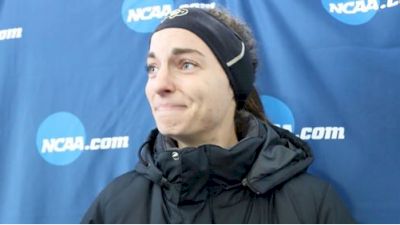The Biggest 'What-Ifs' Of The 2018 NCAA DI XC Championships
The Biggest 'What-Ifs' Of The 2018 NCAA DI XC Championships
How would the 2018 NCAA DI XC Championships have been different if there wasn't snow on the ground? What about if Vincent Kiprop didn't redshirt?

Unlock this article, live events, and more with a subscription!
Already a subscriber? Log In
The NCAA Cross Country Championships didn't deviate too far from expectations.
NAU—the heavy favorite in the men’s competition—completed their three-peat as anticipated, a guy with a 13:15 5000m PR won the men’s race, and a versatile Colorado athlete with a 3000m indoor title took the women’s. Yes, the New Mexico women placing second was a bit of an upset, but I don’t think many would have been too surprised if you told them in September that Colorado, with all their history, would prevail when it counted.
The somewhat predictable results left less room for speculation about the different outcomes that could have happened in Madison. But with all the variables that accompany one race with 31 teams to decide a champion, there are always what-ifs.
Here are a few of the most intriguing:
What if... it didn’t snow?
This was apparently the first time there was snow on the course at the Division I NCAA Cross Country Championships since 1985. That’s a hard stat to believe, but even when it was negative 1 billion degrees in Ames in 2000, there wasn't a flurry.
The snow created a picturesque backdrop for a cross country race and, like all adverse weather conditions, it had some impact on the race. Certainly, the pace was slower because it was so cold, and that combined with the hills made it a much different race than 2017 in Louisville.
If the course in Madison looked like it did during the other two meets on the course this year, would Weini Kelati have made a move sooner? (Kelati mentioned pre-race that she had never raced in snow). And if so, what ripple effects would that have had on the rest of the women’s placings?
Colorado and NAU enjoyed such comfortable wins that a 50-degree day wouldn’t have changed those outcomes, but around the margins, it definitely made a difference. The Arkansas and Villanova women were strong contenders for the podium, but placed 14th and 24th. It’s hard to attribute those drops to simply having an off-day.
What if... the Powell’s didn’t leave Oregon?
The Washington men ran well in their first year under Andy Powell. The presence of Tanner Anderson, who followed Powell from Oregon, was a key part of the team’s sixth-place finish.
But the higher-profile moves happened in the women’s race, where Mauricia Powell’s move triggered the transfer of Lilli Burdon and Katie Rainsberger to Washington, and Weronika Pyzik and Isabelle Brauer to Oregon.
What impact did that have for Oregon's title hopes?
Not much. Pyzik finished 12th, Rainsberger 19th, Burdon 33rd and Brauer 52nd. After moving the points around under the assumption that they would've finished in the same spot without any transfers, Oregon would have netted 12 points—a negligible improvement that would have kept them in third place.
What if... Vincent Kiprop didn’t redshirt?
The Alabama senior entered the season as the top-ranked runner by virtue of his runner-up finish in the 10,000m at the 2018 NCAA Outdoor Championships. But midway through the season, Alabama announced they were redshirting Kiprop, depriving the field of one strong title contender and reliable front-runner.
Kiprop, along with his teammates Alfred Chelanga and Gilbert Kigen, are familiar faces in the lead pack of any race they run. Kigen also decided to redshirt, leaving just Chelanga on the course on Saturday.
But, after watching Pre-Nats and the national championship race, it’s hard to imagine someone out Mantz-ing Conner Mantz. The BYU freshman kept the pace honest, and was unwilling to relinquish the lead for anything less than a court order. Given Chelanga’s finish (12th), Kiprop was a safe bet for top 10, and could have factored into the stretch run between Morgan McDonald, Grant Fisher and Edwin Kurgat.
What if... Dani Jones hadn't redshirted last outdoor track season?
To be clear, Jones would have been a title threat regardless of whether she competed in the NCAA in the spring. In retrospect, however, it’s clear that it was a great decision to redshirt the spring.
Jones had an extremely late start to the indoor season because of injuries--a fact that was glossed over because she still managed to pull out a second-place finish in the mile despite only racing twice. That put her behind in preparation for outdoors, so she decided to sit out the collegiate season to fully prep for her last cross country season.
Even though she didn’t compete for Colorado, she still raced—and she raced FAST. Jones dropped her personal best to 4:07.33 in the 1500m, winning the B section at the Prefontaine Classic and taking fifth at the USATF Championships. She probably could have won the NCAA 1500m, but by waiting, Jones put herself in the best possible position to do what she did last Saturday.